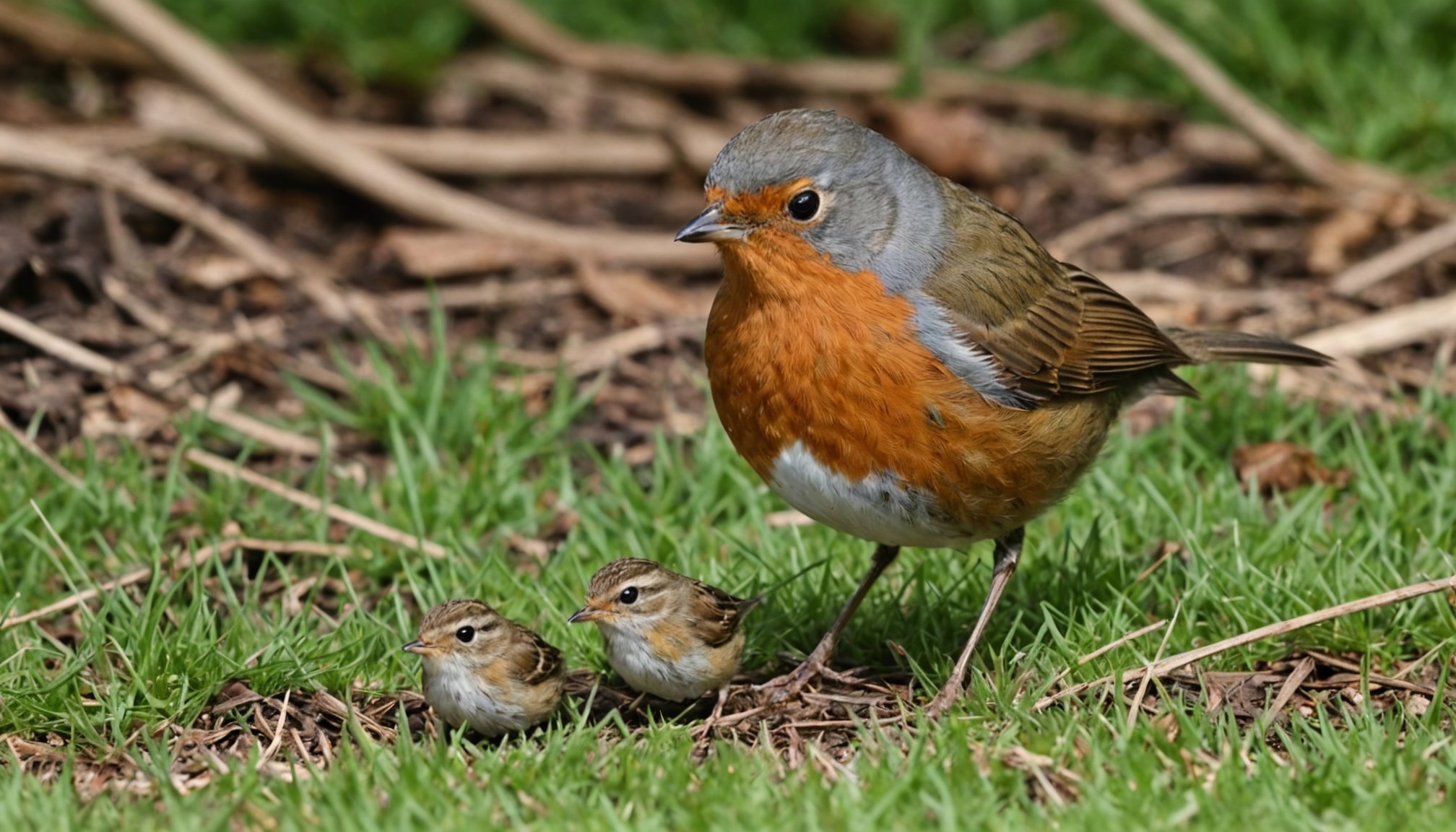The Ultimate Handbook for Successfully Raising Orphaned British Robins: Proven Techniques for Care and Nurture
Raising orphaned British robins can be a rewarding yet challenging task, requiring careful attention to detail and a deep understanding of the birds’ specific needs. Here’s a comprehensive guide to help you navigate this journey, ensuring the best possible outcomes for these young birds.
Understanding the Needs of Orphaned Robins
Before you decide to care for an orphaned robin, it’s crucial to understand their natural behavior and the role of their parents in the wild.
In the same genre : Designing an enchanting prairie dog oasis: essential strategies to celebrate your pet’s burrowing habits
Leaving the Nest: A Normal Part of Development
Young robins often leave their nests before they can fly, a process known as fledging. If you find a baby bird on the ground, it may not necessarily be orphaned. As Ron Hines explains, “If the baby bird is not on the ground, leave it alone. As young birds learn to fly, they leave their nests to perch on adjoining branches and nearby bushes.”[1]
Assessing the Situation
If the baby robin is on the ground and appears to be in distress (weak, injured, soiled, sleepy, or dehydrated), it is best not to attempt to return it to its parents. Instead, consider taking it to a wildlife rehabilitation center. However, if the bird is close to fully feathered but not yet able to perch, you can try placing it in a safe, elevated area to see if its parents will continue to care for it.
Also to read : Creating a wildlife-friendly pet paradise: how to design a garden in the uk that benefits local ecosystems
Creating a Safe and Suitable Environment
Housing the Bird
Providing a safe and appropriate enclosure is vital. Here are some steps to create a suitable environment:
- Initial Housing: Start with a cardboard shoe box or a woven basket lined with shredded, unscented paper towels. Ensure the container has sides high enough to prevent the bird from escaping and is placed in a safe, elevated, shaded area[1].
- Mesh Cage: As the bird grows and gains leg strength, it will need a mesh cage to prevent it from jumping out. Use vinyl mesh window screen on a wooden frame to avoid fraying the bird’s feathers[1].
- Perches and Bedding: Once the bird can grasp your finger, introduce perches made from branches that are not too small in diameter and do not have sharp points. Change the bedding regularly to keep the environment clean and free from mold[1].
Temperature and Lighting
Ensure the enclosure is well-lit and has good air circulation. It should also be amenable to temperature regulation, as extreme temperatures can be harmful to young birds.
Low Stress Environment
Maintaining a low-stress environment is crucial for the bird’s health and mental well-being. Keep the enclosure away from pets and children, and ensure it is clean and uncluttered[1].
Nutrition and Feeding
Diet for Young Robins
Young robins require a diet rich in protein and nutrients. Here are some key points to consider:
- Insect-Based Diet: Robins are primarily insectivorous. Feed them mealworms, calciworms, and other small insects. You can also supplement with fatty foods like suet pellets and mild cheese[3].
- Feeding Schedule: Feed the bird frequently, especially in the early stages. As the bird grows, you can gradually reduce the frequency of feedings but ensure they are still substantial.
- Hydration: Provide fresh water at all times. You can offer water in a shallow dish or use a syringe to gently administer water if the bird is too young to drink from a dish.
Health and Hygiene
Common Health Issues
Young robins are susceptible to various health issues, including parasites and infections.
- Parasite Control: Regularly check for parasites like mites and fleas. Use treatments like spinosad for mites and pyrantel pamoate for intestinal parasites, following the recommended dosages and intervals[2].
- Hygiene Practices: Keep the enclosure clean by changing the bedding frequently and ensuring all utensils and feeding equipment are sanitized.
Monitoring Health
Regularly monitor the bird’s health, looking for signs of illness such as lethargy, loss of appetite, or unusual droppings. If you notice any of these symptoms, consult with a wildlife rehabilitation expert or a veterinarian.
Socialization and Development
Importance of Socialization
Socialization is critical for young robins to develop normal behaviors and vocalizations.
- Genetic and Learned Behaviors: Young birds have an innate ability to produce certain sounds, but they also learn from their environment. If raised in isolation, they may develop songs based on other species they hear[4].
- Interaction with Humans: While it’s essential to minimize handling to reduce stress, some interaction can help the bird become less fearful of humans. However, ensure this interaction is gentle and does not interfere with the bird’s natural development.
Preparing for Release
Readiness for Release
Before releasing the robin back into the wild, ensure it meets certain criteria:
- Flight Capability: The bird should be able to fly confidently and avoid predators.
- Foraging Skills: It should be able to forage for food independently.
- Feather Condition: The bird’s feathers should be in good condition, providing adequate insulation and protection.
Release Techniques
When releasing the bird, choose a safe location with ample food and water sources.
- Release in a Familiar Area: Release the bird in an area where it has been kept, so it can quickly find food and shelter.
- Avoid Peak Predator Hours: Release the bird during times when predators are less active, such as early morning or late afternoon.
Practical Tips and Advice
Tips for Parents and Caregivers
Raising an orphaned robin can be a family affair, teaching children valuable lessons about responsibility and wildlife care.
- Involve Children: Encourage children to help with feeding and monitoring the bird, under adult supervision.
- Educational Opportunities: Use this experience as a teaching moment to discuss the importance of wildlife conservation and the life cycle of birds.
Common Mistakes to Avoid
Here are some common mistakes to avoid when raising an orphaned robin:
- Over-Handling: Minimize handling to reduce stress and prevent the bird from becoming too tame.
- Inadequate Nutrition: Ensure the bird receives a balanced diet that meets its nutritional needs.
- Poor Hygiene: Maintain a clean environment to prevent the spread of diseases.
Raising an orphaned British robin is a significant undertaking that requires dedication, patience, and a deep understanding of the bird’s needs. By following these guidelines, you can provide the best possible care and increase the chances of a successful release back into the wild.
Final Thoughts from Experts
“As people who devote their time to raising and releasing wild birds tend to be highly opinionated, it’s important to follow proven techniques and seek advice from experienced wildlife rehabilitators,” notes Ron Hines[1].
By combining these proven techniques with a commitment to providing high-quality care, you can make a meaningful difference in the life of an orphaned robin and contribute to the conservation of these beautiful birds.
Detailed Checklist for Raising Orphaned Robins
-
Housing:
-
Cardboard shoe box or woven basket
-
Vinyl mesh window screen cage
-
Perches made from branches
-
Shredded, unscented paper towels for bedding
-
Nutrition:
-
Mealworms and calciworms
-
Suet pellets and mild cheese
-
Fresh water
-
Frequent feedings in early stages
-
Health and Hygiene:
-
Regular parasite checks
-
Use of spinosad and pyrantel pamoate as needed
-
Clean enclosure and utensils
-
Monitor for signs of illness
-
Socialization and Development:
-
Minimize handling
-
Provide interaction to reduce fear of humans
-
Ensure genetic and learned behaviors are supported
-
Release Preparation:
-
Ensure flight capability and foraging skills
-
Check feather condition
-
Release in a safe, familiar area
Comparative Table: Nutrition and Health Care for Orphaned Robins
| Aspect of Care | Recommendations | Why It’s Important |
|---|---|---|
| Housing | Cardboard shoe box or woven basket with vinyl mesh cage | Prevents escape and injury, provides a safe environment |
| Nutrition | Mealworms, calciworms, suet pellets, mild cheese | Provides necessary protein and nutrients for growth |
| Hydration | Fresh water at all times | Ensures the bird stays hydrated and healthy |
| Parasite Control | Regular checks, use of spinosad and pyrantel pamoate | Prevents parasite infestations and related health issues |
| Socialization | Minimize handling, gentle interaction | Supports normal behavior and vocal development |
| Release | Ensure flight capability, foraging skills, and good feather condition | Increases chances of survival in the wild |
By following this comprehensive guide, you can ensure that the orphaned robin in your care receives the high-quality nurturing it needs to thrive and eventually return to its natural habitat.









